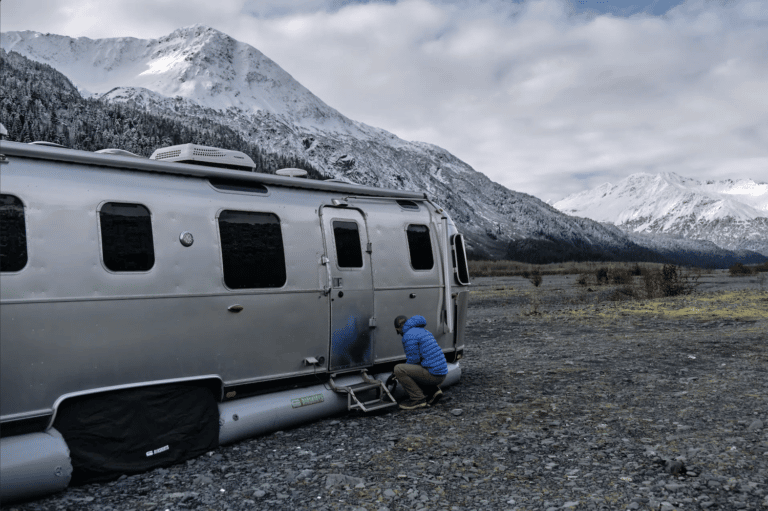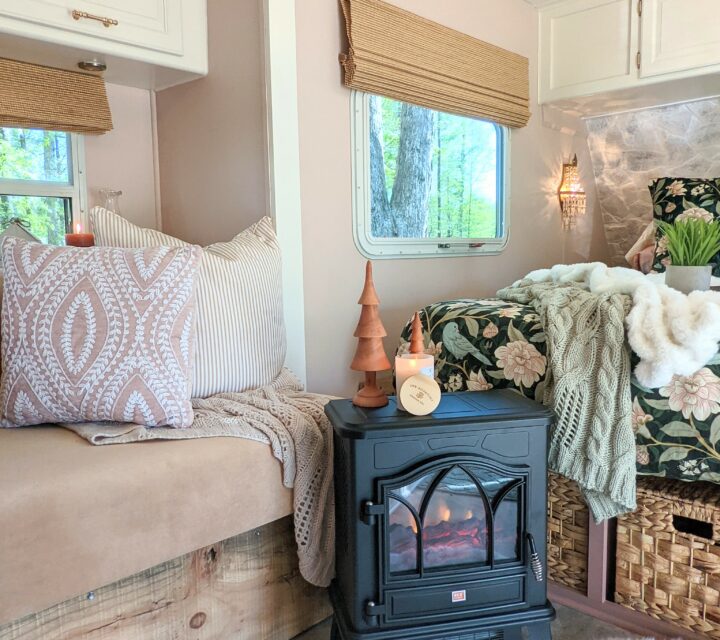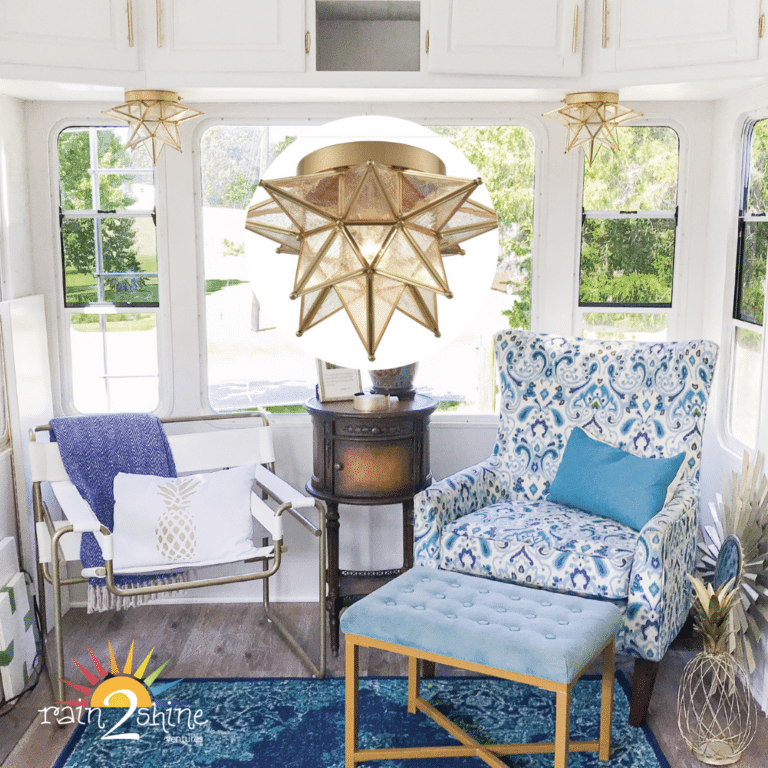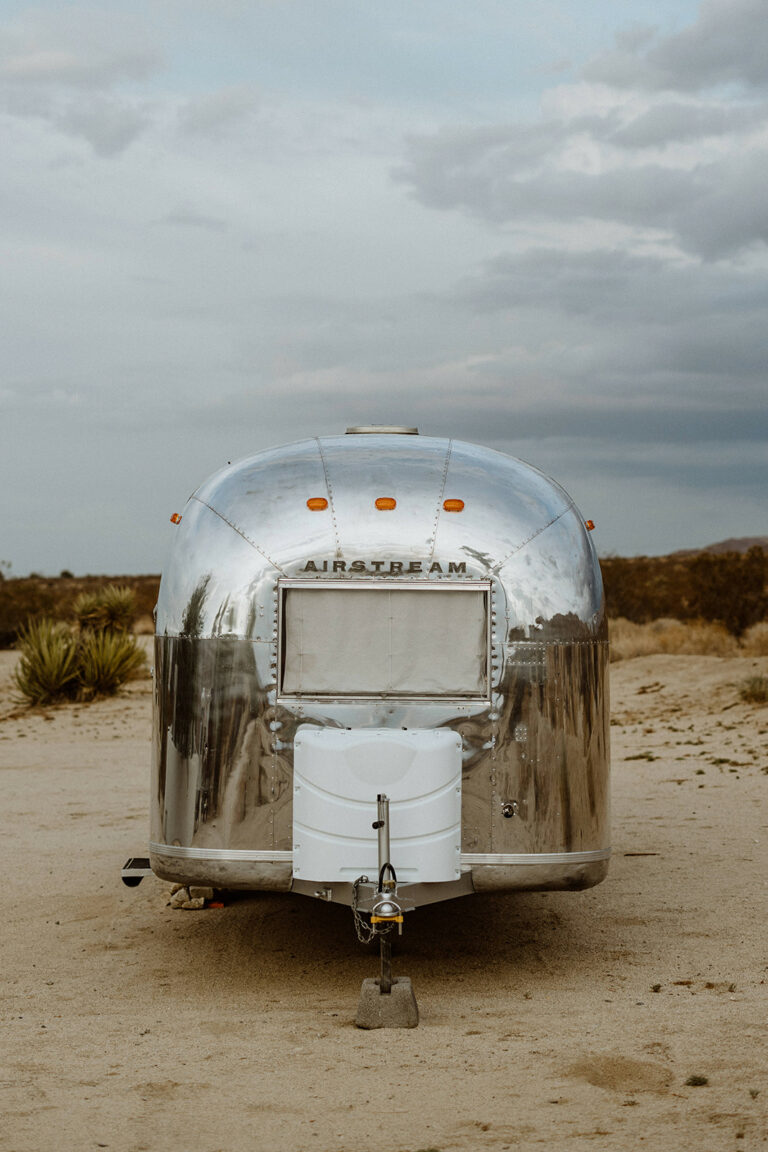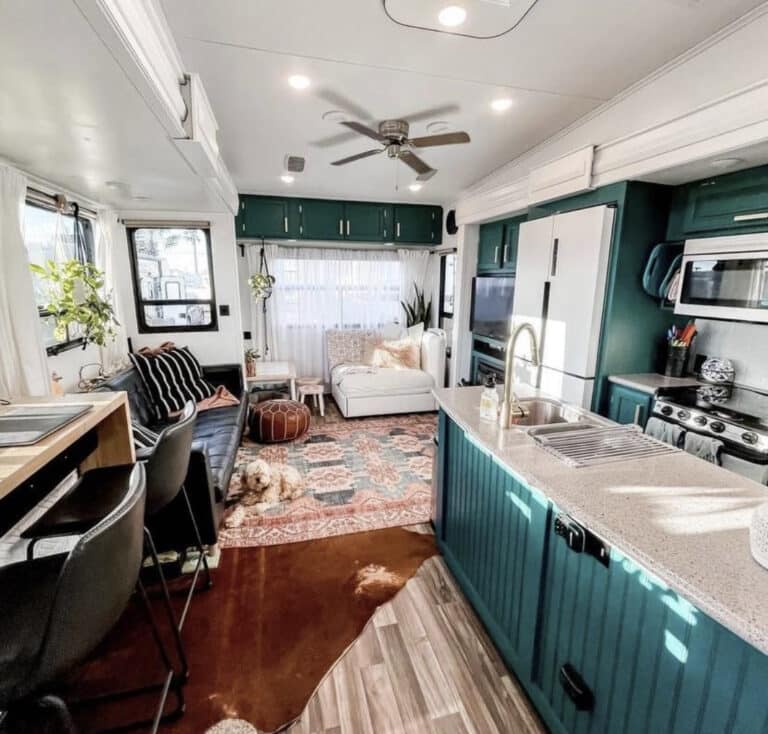How to Update Your Existing RV Shower: 3 DIY Ideas
This post may contain affiliate links.
If you hate your RV shower, you are not alone. You can upgrade and update your RV shower as a DIY project—especially if you have a little plumbing experience!
Updating an RV shower doesn’t require a professional, but it does require ventilation and a hot shower afterward because it’s a dirty job ?
Instead of replacing your RV shower/tub, you can give it a makeover for a fraction of the price…IF you’re willing to put in the work.
How to Upgrade or Replace Your RV Shower – Key Summary
There are three affordable options to update your RV shower using paint, epoxy, and two different types of tile. While a DIYer can accomplish any of these projects, we’ve shared detailed tutorials below to guide you through things to consider, tools to use, and what skills may require a professional.
Our favorite way to quickly update your RV shower on a budget involves a little paint! (Yes, you can paint your RV shower!)
How to Update Your RV Shower DIY Option 1: Epoxy and Paint the Shower Frame
What You Need:
- Rust-Oleum Tub & Tile Kit
- Scotch Brite Pad/Sandpaper
- Impact Driver
- Razor Blade
- SEM Etching Primer (black) OR Rust-Oleum Primer (white)
- SEM Trim Black (or a paint color of your choosing)
- Lacquer Thinner or Rubbing Alcohol
- 4” Foam Roller
- Frog Tape
- Black Silicone Seal (or a silicone color of your choosing)
- Gloves
- Goggles/Glasses
- Face Mask
- New Screws/ Hardware to match the frame
- Rags/Paper Towels/Wipes
How to Update the Shower Frame:
The Professional Option:
The optimal way to treat your shower frame (for long lasting results) is to sandblast and powder coat it. Unfortunately, this is not something you can DIY though. You will have to search for sandblasters and powder coaters in your area; often powder coaters have their own sandblasting machines. You will then need to remove the glass and take the frame to them for this application. In our area, this isn’t very expensive (less than $100). However, while it costs more than the option described below, it will hold up to wear and tear much better than the option of painting that we explain next.
The DIY Option:
Give your shower surround a deep clean before we bring it back to life.
- Remove the shower frame (optional, but can make the job easier, particularly if you want or need to rework plumbing for a different type of showerhead, i.e. rainfall)
- Locate and remove the screws to the individual shower panels that connect them to one another–this makes it easier to fit them through the door to take them outside. Then, locate and remove the screws in connection to the walls.
- Remove/scrape off any built-up gunk, glue, caulk, etc, using a razor blade scraper or something similar.
- Scuff up the shower frame with sandpaper or a scotch bright pad. This will create a surface that the paint can stick to when you’re ready. Note: Skip this step if you don’t want to change the color of your shower frame.
- Clean the shower frame and panels with lacquer thinner, rubbing alcohol, or something similar.
- Tape off shower panels with Frog Tape to avoid getting paint on the glass during the next step.
- You can also use Kraft Paper to help cover more of the glass panels.
- Prime the shower frame with one coat. We use SEM Black Etching Primer. Rust-Oleum also makes spray primers.
- Spray paint the shower frame with multiple coats. We typically use SEM Black Trim for metal shower frames but you can use whatever color you choose.
- Remove tape and use a razor to scrape off any spots where the paint bled through.
More Like This: Why Is My RV Shower Turning Yellow? How to Fix a Yellow Camper Shower
How to Update the Shower Pan
- Scrape off any built-up gunk, glue, caulk, etc. using a razor blade scraper or something equivalent. Be very careful as to not damage the liner and base with the razor. Take your time and be gentle.
- Scuff up the shower with sandpaper or a scotch bright pad. This will create a surface that the refinishing kit can adhere to strongly.
- Remove pieces that you can such as: hardware (shower head, knobs, drains), etc.
- Clean shower surfaces with rubbing alcohol, lacquer thinner or something similar.
- Dry all shower surfaces–the pan and walls.
- Open any and all windows for ventilation, apply a face mask (at the very least), goggles/glasses, and gloves.
- Follow the instructions on the box of the Rust-Oleum Tub & Tile Kit, which says:
- Stir “Part A” (The Activator) of the kit and “Part B” (The Base/Paint) separately before combining “Part A” and “Part B”.
- Use a roller. We use a 4” high-quality foam roller.
- Apply 2+ coats with an hour between each coat.
- Notes:
- This epoxy acrylic is self-leveling. You will see bubbles, which should eventually level out for a smooth surface.
- You only have a 6-hour window after mixing to finish applying coats.
- We use one kit for a standard RV shower/tub.
- The temperature should be moderate; 70 degrees with a humidity of 50% or less is ideal.
- If you want black instead of white, we advise using this Black Paint Refinishing Kit.
- Wait at least 72 hours before exposing the shower to water, and then you’re DONE with the fumes and almost done with the hard work!!
Reinstalling (if necessary)
- Screw the shower panels back to the shower walls. If there’s a center shower panel, connect it last. NOTE: If you changed the shower frame color, you may need to get new screws to match, instead of using the original screws.
- If you’re swapping out your hardware–shower head, knobs, etc. this is the time to do it!
- Don’t forget to reseal the shower frame around the base and walls! We typically use black silicone if the frame is painted black but silicone comes in many colors such as black, white, silver, etc. so take your pick.
- Step back and relish in your hard work and pass the message along that this may be the easy way, but it is not fun…just kidding! YOU DID IT, GREAT JOB!!!
How to Upgrade Your RV Shower DIY Option #2: Tile (and not peel and stick!)
Note 1: This will add weight to your RV. However, it shouldn’t add enough to make a big difference. If you’re concerned about weight, you can measure the square footage and weigh the amount of tile it will take beforehand to be safe. Tile varies in weight with some being much lighter than others, so if weight is an issue, stay on the lighter side with a thinner tile.
Note 2: Yes, tile and grout can crack…especially in a rolling home. However, after 4 years of full-time RV living with moderate travel, I can honestly say that we have never had any cracks or breaks in any of our tiles including our kitchen backsplash, entire bathroom floor and backsplash. I’ll detail the process I used below.

What You Need:
- Frog Tape
- Concrete Board
- Circular Saw
- AquaDefense
- Impact Driver
- MusselBound Adhesive Tile Mat
- MusselBound Waterproofing Seam Tape
- Tile
- Grout
- Sponge
- Bucket
- Optional items, depending on if you’re epoxying the base/pan: Rust-Oleum Tub & Tile Kit OR Black Paint Refinishing Kit, Scotch Brite Pad/Sandpaper, Razor Blade, Lacquer Thinner or Rubbing Alcohol, 4” Foam Roller, Gloves, Rags, Goggles/Glasses, Face Mask
- Optional items depending on if you’re painting the shower frame: Scotch Brite Pad/Sandpaper, Lacquer Thinner or Rubbing Alcohol, Rags, SEM Etching Primer (black) or Rust-Oleum primer (white), SEM Trim Black (or a spray paint color of your choosing), new screws/hardware to match the frame, Black Silicone Seal (or a silicone color of your choosing)
How to Tile Your RV Shower
- Remove Shower Frame
- Locate and remove the screws to the individual shower panels that connect them to one another–this makes it easier to fit them through the door to take them outside. Then, locate and remove the screws in connection to the walls.
- Remove the shower liner. The manufacturers typically install the liner with a few hidden screws (covered with caps that match the liner) and glue. These are pretty flimsy and, quite frankly, not exactly waterproof. Over time, moisture can get behind the liner causing mold and mildew to grow. Find the hidden screws and pull the liner out.
- Remove the shower pan or tub: This step is optional depending on if you’re keeping or replacing the base. If the pan or tub works for you, I recommend giving it a “makeover” as described above with the epoxy tub and tile kit. If you’re creating a new or larger space for your shower, you will need to find a new pan/tub to fit that space. If you’re keeping the base, cover and tape off for protection. If not, you’ll need to find and remove the screws in order to take out the base.
- If you’re installing a new pan or tub, install it now. You may need to reinforce the floor if you’re installing a large tub. Follow the instructions included with your specific product and see the article below for more tips.
Read Next: 9 Alternative RV Bathtub Ideas: Adding a Tub to Your RV
Replace RV Shower Pan – Where to Find a Replacement
I’ve never replaced a shower tub or pan in a camper that I’ve renovated because I haven’t needed to. If your tub or pan is cracked or needs replacing or you’re attempting an RV tub to shower conversion, finding the perfect fit for a replacement or the perfect size for your expanded shower can be difficult.
Here are a few places I recommend to look for a new RV shower pan or tub:
How to Tile Your RV Shower – Continued!
- Locate the studs in your walls and mark with Frog Tape on the ceiling and the base (pan or tub). This avoids covering up your marks when placing the concrete board.
- Measure the walls by the ceiling, base, and on each side. Important Note: RVs aren’t made completely straight or at perfect 90 degree angles. Your measurements by the ceiling and base and/or sides will likely be slightly different from a sixteenth to a half inch.
- Cut the concrete board with a circular saw to fit the walls based on your measurements.
- Install the concrete board(s) with screws (minimum 1-⅝”) along the studs making sure they are flush with the concrete board.
- Apply AquaDefense. This ensures your new walls are completely waterproof. You do NOT want to do this before installing. If you apply this to the boards before installing, the screws will create areas where water can seep through and cause damage. This is why you want to apply after the boards are installed, covering the board, screws and any gaps between the board and screws. It will take 2-3 coats of AquaDefense. Make sure to read their directions and apply accordingly.
- Tile! If you’re new to tiling, we have a complete tutorial on how to add tile in an RV (including why flexible grout is a must!)
- If you’re keeping the current base (tub or pan), remove the cover and tape. Also, remove the drain and cover the hole with Frog Tape. See above for step-by-step instructions under Shower Pan & Liner.
- From here, you can reinstall the shower frame and reseal whether you choose to sandblast/powder coat, paint, or install a shower curtain. Step-by-step instructions for the frame are above under Reinstalling. NOTE: If you have to screw through the tile you installed to reinstall the shower frame, you will need a bit to pre-drill and accommodate the type of tile you used to avoid breaking the tile.
DIY Option #3: Interlocking Wall Tiles
Note: Weight is not as much of a factor for this type of tile as they are a very lightweight (typically) vinyl product. This type of installation is fairly easy and doesn’t require any all-set or grout as the tiles are interlocking and waterproof.

What you need:
- AquaDefense (optional)
- Liquid Nail OR Loctite
- Impact Driver
- Frog Tape
- RTD Sheathing
- Optional items depending on if you’re epoxying the base/pan: Rust-Oleum Tub & Tile Kit OR Black Paint Refinishing Kit, Scotch Brite Pad/Sandpaper, Razor Blade, Lacquer Thinner or Rubbing Alcohol, 4” Foam Roller, Gloves, Rags, Goggles/Glasses, Face Mask
- Optional items depending on if you’re painting the shower frame: Scotch Brite Pad/Sandpaper, Lacquer Thinner or Rubbing Alcohol, Rags, SEM Etching Primer (black) or Rust-Oleum primer (white), SEM Trim Black (or a spray paint color of your choosing), new screws/hardware to match the frame, Black Silicone Seal (or a silicone color of your choosing)
How to Install Interlocking Wall Tiles
- Follow steps 1-8 in the previous section on how to install real tile for the removal of the frame and liner, as well as how to install concrete board. However, you don’t have to use concrete board for this type of tile. You will still need to install a sturdier and thicker material since the walls behind the shower are likely ¼” plywood and aren’t strong enough to hold the added weight. I recommend at least ½” thickness. Here is one (¾”) option: RTD Sheathing
- These tiles are supposed to be fully waterproof and interlocking. However, if you want to be extra cautious, I recommend following step 9 in the previous section for applying AquaDefense.
- Install the tile using Liquid Nail or Loctite. You will have to make a few cuts for the corners and top/bottom but these tiles are large and cover a lot of area so it’s a lot less labor and time than real tile.
- Follow steps 11-12 in the previous section to complete the project.
Examples of Interlocking Wall Tile:
- DumaWall Smooth Carrara Marble Composite Faux Marble Wall Panel
- Palisade Matte PVC Random Stone Look Interlocking Wall Tile
How to Add a Bath Tub To Your RV
I’ve already noted this before, but if you’re looking to add a bathtub to your RV, head over to this post for RV bathtub ideas.
How to Replace the Shower Head and Faucet in Your RV
We have a complete guide on how to replace RV shower fixtures that shows how this is a lot simpler than it seems.
FAQs: Updating an RV Shower
1. Will any showerhead fit an RV shower?
You can use any type of shower head and faucet in an RV. However, both will depend on the amount of space you have for each (particularly the handles for the faucet) and your plumbing skills.
We typically have to rework the plumbing slightly (i.e. add fittings, couplers, etc.) to replace/update both. A “rain” shower head will require plumbing knowledge/skills.
2. Can you put a regular shower in an RV?
You can use a shower surround or tile meant for a residential home in an RV. Just be sure to check dimensions as well as weight to ensure the product will work in your space.
3. What is the best showerhead for an RV?
This is heavily debated! There is no “best” since everyone enjoys different types of showers, but here are a few popular ones. Warning: the more beautiful the showerhead, the bigger the price tag.
- ✅ Best RV Shower Head Replacement: Awelife offers 5-function handheld shower head kit with all awesome accessories and perfect workmanship to update to a super value shower.
- ►METAL RAIN SHOWER HEAD AND HAND SHOWER WAND: Square design rain shower head and hand shower wand are made from stainless steel and brass. METAL construction is more durable than plastic, and provides a longer service life
- HIGH PRESSURE RAINFALL SHOWER HEAD: Our luxury bathroom rainhead is the perfect replacement that will jet out high-pressure rain of hot water so your whole body is doused with the downpour. You won’t go back to a normal shower again
- 3-Function Antique Brass Shower Fixture: 8 Inch rainfall shower head covers your whole body, handheld shower with 59 Inch shower hose, and waterfall tub swivel spout quickly fills your tub in a few minutes
Read Next: You Won’t Believe The Shower in This Toy Hauler Renovation
4. How to increase water flow in an RV shower?
Water flow is largely dependent on your water source or your onboard water pump. Use a water pressure regulator to check your water pressure.
- Best quality regulator on the market. Get the only regulator that is quality tested in the US using American standards, comes with a 1-year warranty and lifetime US-based support (available on packaging), and is made with superior quality brass and a more durable, liquid-filled gauge.
5. Can you put tile in an RV shower?
Yes! You can use tile, though there are few key differences during install compared to tiling a residential shower. See this complete tutorial for details.
6. How can I actually enjoy my RV shower?
Install a tankless water heater to ensure you never run out of hot water AND make sure your tanks aren’t full or almost full before stepping in the shower. No one wants to run outside in a towel to dump the tanks…yikes!
How Will You Update Your RV Shower?
Updating your RV shower is a great way to make your RV bathroom feel brand new no matter how old your RV is. Whether your existing RV shower is cracking, yellowing, or just ugly enough to ripped out and replace with tile, this is a DIY project that will breathe new life into your home on wheels.
Get More RV Bathroom Inspiration:
- 8 Awesome RV Shower Makeover DIY Ideas
- Fun Bathroom Mirror Inspiration for Your RV Bathroom Remodel
- RV Bidet: Top Options and How to Install
As a full-time RV-er with decades of interior design experience, I pour my heart and soul into rain2shine ventures. I bring passion and creativity to each project, prioritizing functionality and style. I wear many hats at r2s; not only am I running a successful business, I design every remodel, tackle much of the labor and decorate each project to bring a client’s vision to life.
Rain2shine ventures and myself have been featured on the cover of RV Enthusiast, in O’Henry Magazine, WFMY News 2, and a handful of other publications.













